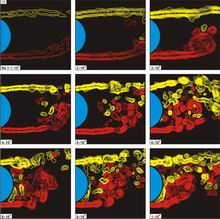You are here
Home ›Near-Wake Structure of a Cylinder: Effect of Reynolds Number
Near-Wake Structure on a Cylinder: Effect of Reynolds Number. Flow past a circular cylinder can give rise to distinctly different patterns of the near-wake structure over the range of Reynolds numbers from 1,000 to 10,000. The image layout shows patterns of instantaneous vorticity ω. At the lowest values of Reynolds number Re = 1 × 103 and 2 × 103, the initially-formed vortex occurs at or just beyond the right edge of the field of view. At Re = 3 × 103, small-scale vortical structures appear about the periphery of the large-scale vortex originating from the bottom surface of the cylinder. Further increases of Reynolds number yield well-defined small-scale structures immediately prior to formation of the large-scale vortical structure. These concentrations arise from a Kelvin-Helmholtz instability of the separating shear layer. For example, at Re = 5 × 103, small-scale concentrations are evident at the right end of the separated vorticity layer, as well as within the large-scale vortex that results from rollup of this layer. At Re = 6 × 103, the initially-formed concentration of vorticity moves upstream in the separating shear layer until, at Re = 1 × 104, it appears close to the separation point. Corresponding patterns of Reynolds stress (not shown) indicate that the magnitudes of these stresses increase with increasing Reynolds number and, as shown in the present image layout, the end consequence is upstream movement of the initially-formed, large-scale Kármán (vortex). At the highest value of Re = 1 × 104, it is immediately adjacent to the base of the cylinder.

It is well known that the fluctuating lift and base pressure coefficients on a circular cylinder undergo large changes with increasing Reynolds number over the range extending approximately from 103 to 104. These variations of the loading, obtained in previous investigations, are physically interpreted herein with wholefield patterns of the flow structure. A central feature is the earlier onset of small-scale vortical structures in the separating shear layer with increasing Reynolds number. These structures substantially enhance the level of Reynolds stress correlation in the separating shear layer. In turn, it is demonstrated that this enhancement is associated with: the onset of pronounced cross-stream velocity, i.e., entrained flow into the shear layer, which is particularly evident in the base region at higher values of Reynolds number; and the onset of a negative pocket of streamwise velocity, which migrates upstream with increasing Reynolds number. The overall consequence of these alterations of the near-wake is a substantial decrease in formation length of the large-scale Kármán vortex, which is interpreted via patterns of phase-referenced instantaneous velocity and time-averaged vorticity.
